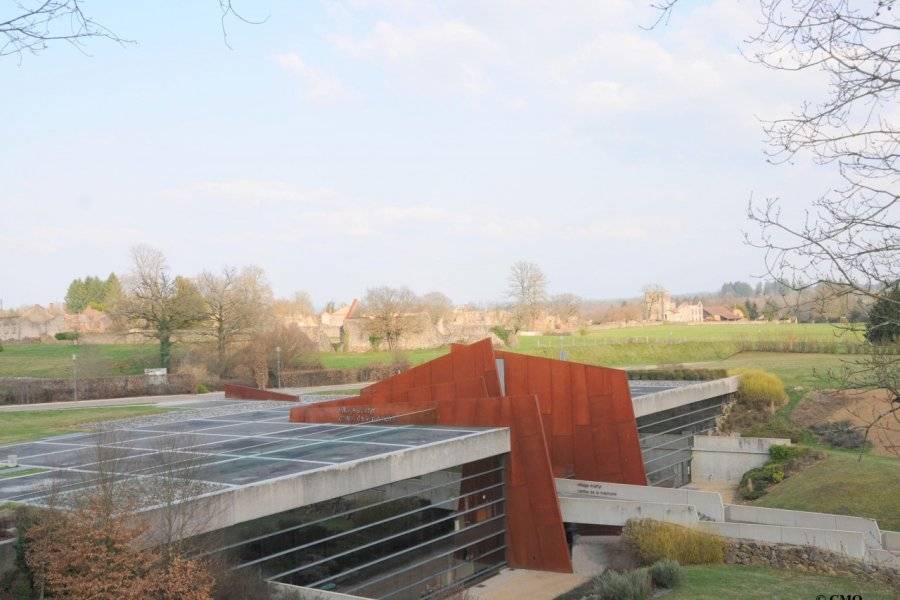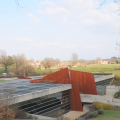MEMORY CENTER - MARTYR VILLAGE
Center de la mémoire with elevators, presenting an exhibition fully accessible to people with reduced mobility
This Center of Memory is a sort of link between the martyred village and the new village, like a link between the past and the future. Inaugurated in 1999 in the presence of Jacques Chirac, it contributes to the indispensable duty of remembrance by providing the necessary information to understand the drama that took place in this peaceful village of Haute-Vienne at the end of the Second World War. Its creation has also allowed the new town, whose first steps were taken in 1953, to continue its slow work of reconstruction. The Centre de la Mémoire is located at the entrance to the new Oradour and near the ruins of the martyred village, halfway between the new church and the one in which the massacre of 350 women and children was perpetrated. For many inhabitants of Oradour, especially for the families of the martyrs, the creation of such a place was indispensable. To pay homage to the victims of the Nazi murderous madness, but also to keep the memory of the Oradour massacre alive in people's minds once the last witnesses have disappeared.
The journey of memory leads the visitor from 1933 to 1953, from the expansion of Nazism in Europe to the trial in Bordeaux. Five exhibition areas provide a better understanding of the historical reality and the exemplary nature of Oradour: the rise of Nazism, the French defeat, collaboration and resistance, the politics of terror, the days of June 8 and 9, 1944, the story of the tragedy of June 10, national recognition, the trials and amnesty, the reconstruction of Oradour, and a reflection on the tragedy. Also to be seen outside, the statue dedicated to the martyrs of Oradour-sur-Glane. Since its opening, the Centre de la Mémoire has set itself two objectives: to understand and to learn. To help the approximately 130,000 annual visitors, including 30,000 schoolchildren, take the measure of the events perpetrated at Oradour-sur-Glane, the center does its best to incorporate, alongside its historical exhibits, the personal stories of the victims. Since 2018, one can contemplate a fresco made from the portraits of those who lost their lives during the massacre. One shudders in front of the 642 porcelain plaques, installed here like so many funerary plaques, on which have been affixed, thanks to the know-how of a local craftsman, the faces of the known victims. The eyes of the martyrs of Oradour-sur-Glane stare at us, move us and stay with us for a long time. A visit to the Centre de la Mémoire is not complete without a visit to the ruins of the martyred village. They cover an area of 15 hectares and have been maintained in the state they were in after the massacre. Signs invite visitors to meditate on the paths and roads where bullet holes are still visible on the walls as well as cars and rails left behind. The preservation of this village after the massacre bears witness to this atrocious barbarity for future generations. Oradour is a symbol of a France wounded by the German occupation.
The testimonies of the survivors have made it possible to reconstruct with precision the way in which the events unfolded on June 10, 1944. Six people survived the massacre: five men and one woman. Few accounts carry as much weight as that of Marguerite Rouffanche, a 47-year-old resident of the village at the time. She was the only survivor of the church, in which 350 women and children of Oradour were locked up and cowardly murdered by the soldiers of the2nd "Das Reich" division. She managed to escape through a window and gave her first testimony to the hospital and then to the prefect of Limoges, a few days after the events. Thereafter, she continued to share her story and the horror of the acts she witnessed. Marguerite Rouffanche recounts how women and children were separated from the men, then piled up by the German soldiers in the village church. On the floor, in front of the holy table, she noticed a large box, connected to cords, which she then understood was a bomb. Marguerite is locked up in the church with her two daughters and her grandson. When the bomb exploded, the building did not collapse, as the Germans had hoped, but filled the church with black smoke and caused a panic. The Germans were determined to shoot women and children and set fire to the church. Marguerite took refuge in the sacristy; before her eyes, one of her daughters fell under the gunfire, while the other was burned alive. With the help of a stepladder, she managed to climb out of the largest window in the church, despite being shot five times, and fell three meters outside. She remained hidden in a garden for nearly 24 hours before finally being rescued. The accounts of the executors, heard by the courts, are also valuable sources of information. The participants in the massacre were tried at the Bordeaux trial, which opened on January 12, 1953. Among the sentences handed down, some targeted thirteen Malgré-Nous, Alsatians and Moselleans who were drafted into the Wehrmacht.
Did you know? This review was written by our professional authors.
The strengths of this establishment:
Members' reviews on MEMORY CENTER - MARTYR VILLAGE
The ratings and reviews below reflect the subjective opinions of members and not the opinion of The Little Witty.





Les documents sont là pour aider à comprendre la tragédie.
Le parcours retrace bien les dernières heures de ces malheureux...